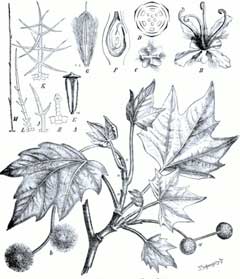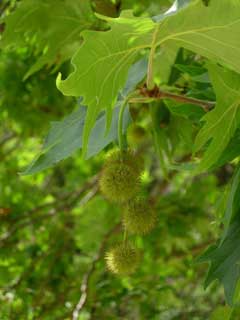 |
|
http://commons.wikimedia.org/wiki/File:Platanus_occidentalis_GS344.png |
 |
| http://commons.wikimedia.org/wiki/User:Bruce_Marlin |
Translate this page:
Summary
Bloom Color: Red. Main Bloom Time: Early spring, Late spring, Mid spring. Form: Pyramidal, Rounded.
Physical Characteristics

 Platanus occidentalis is a deciduous Tree growing to 30 m (98ft) by 30 m (98ft) at a fast rate.
Platanus occidentalis is a deciduous Tree growing to 30 m (98ft) by 30 m (98ft) at a fast rate.
See above for USDA hardiness. It is hardy to UK zone 5. It is in flower in May, and the seeds ripen from October to March. The species is monoecious (individual flowers are either male or female, but both sexes can be found on the same plant).
Suitable for: light (sandy), medium (loamy) and heavy (clay) soils. Suitable pH: mildly acid, neutral and basic (mildly alkaline) soils. It cannot grow in the shade. It prefers moist or wet soil and can tolerate drought. The plant can tolerates strong winds but not maritime exposure.
It can tolerate atmospheric pollution.
UK Hardiness Map
US Hardiness Map
Synonyms
P. hispanica. Hort (pro parte). P. macrophylla. Hort. (pro parte). P. vulgaris angulosa.
Plant Habitats
Woodland Garden Canopy; Bog Garden;
Edible Uses
Edible Parts: Sap
Edible Uses: Sweetener
The sweet sap is tapped in the spring and used in the preparation of syrup and sugar[105, 177, 183].
References More on Edible Uses
Medicinal Uses
Plants For A Future can not take any responsibility for any adverse effects from the use of plants. Always seek advice from a professional before using a plant medicinally.
Antirheumatic Astringent Diuretic Dysentery Emetic Laxative Poultice Salve
The inner bark is astringent, diuretic, emetic and laxative[222]. It has been used as a tea in the treatment of dysentery, coughs, colds, lung ailments, haemorrhages, measles, milky and difficult urination etc and also as a blood tonic[222, 257]. Externally, it has been used as a wash on wounds[257]. An infusion of the bark and roots has been used as a foot soak for treating rheumatism[257]. The bark ooze has been used as a wash on infected sores and an infusion has been given in the treatment of infant rash[257]. An infusion of the bark, mixed with honey locust bark (Gleditsia triacanthos), has been used as a gargle to treat hoarseness and sore throat[257].
References More on Medicinal Uses
The Bookshop: Edible Plant Books
Our Latest books on Perennial Plants For Food Forests and Permaculture Gardens in paperback or digital formats.

Edible Tropical Plants
Food Forest Plants for Hotter Conditions: 250+ Plants For Tropical Food Forests & Permaculture Gardens.
More

Edible Temperate Plants
Plants for Your Food Forest: 500 Plants for Temperate Food Forests & Permaculture Gardens.
More

More Books
PFAF have eight books available in paperback and digital formats. Browse the shop for more information.
Shop Now
Other Uses
Shelterbelt Wood
A fairly wind resistant tree, it can be grown as part of a shelterbelt planting[200]. Wood - coarse-grained, tough, strong, very durable, difficult to split[46, 61, 171]. Rather weak according to other reports[227, 229]. It weighs 35lb per cubic foot[235], and is used for furniture, chopping boards etc[46, 61, 171, 229]. Trunks of wild trees can be up to 4.5 metres in diameter and these were at one time hollowed out to make barges capable of carrying several tons of goods[226].
Special Uses
References More on Other Uses
Cultivation details
Landscape Uses:Aggressive surface roots possible, Pollard, Seashore, Specimen, Street tree. Prefers a deep moist loam[1], though it tolerates very wet, poorly drained soils[229]. Requires full sun[200]. Tolerates atmospheric pollution and compacted soils[200]. Established plants are drought tolerant[200]. Fairly wind-resistant[200]. A fast-growing and long-lived tree[200, 229], but it is of no value in Britain, being very susceptible to attack by parasitic fungi[11]. Fairly slow-growing according to another report, which also says that the tree is long-lived in the wild[227]. This species does not do well north of Central France, it requires long hot summers to fully ripen its wood[200]. Special Features:Attracts birds, North American native, Inconspicuous flowers or blooms.
References Carbon Farming Information and Carbon Sequestration Information
Temperature Converter
Type a value in the Celsius field to convert the value to Fahrenheit:
Fahrenheit:
The PFAF Bookshop
Plants For A Future have a number of books available in paperback and digital form. Book titles include Edible Plants, Edible Perennials, Edible Trees,Edible Shrubs, Woodland Gardening, and Temperate Food Forest Plants. Our new book is Food Forest Plants For Hotter Conditions (Tropical and Sub-Tropical).
Shop Now
Plant Propagation
Seed - two months cold stratification improves germination[113]. Sow spring in a cold frame in light shade[78, 98]. Home grown seed is often of poor quality and low viability. It is best to harvest the seed in late winter or spring and then sow it immediately in a cold frame[80]. When they are large enough to handle, prick the seedlings out into individual pots and grow them on in the greenhouse for their first winter. Plant them out into their permanent positions in late spring or early summer, after the last expected frosts. Cuttings of mature wood of the current years growth, 20 - 30 cm with a heel, autumn in a cold frame[1]. Easy[200]. Layering of stools in spring or autumn. Takes 12 months[78].
Other Names
If available other names are mentioned here
Native Range
NORTHERN AMERICA: Canada (Ontario (south)), United States (Connecticut, Maine, Massachusetts, Michigan, New Hampshire, New Jersey, New York, Ohio, Pennsylvania, Rhode Island, Vermont, Illinois, Iowa, Kansas, Missouri, Nebraska, Oklahoma, Wisconsin, Alabama, Arkansas, Delaware, Florida, Georgia, Kentucky, Louisiana, Maryland, Mississippi, North Carolina, South Carolina, Tennessee, Virginia, Texas)
Weed Potential
Right plant wrong place. We are currently updating this section.
Please note that a plant may be invasive in one area but may not in your area so it's worth checking.
Conservation Status
IUCN Red List of Threatened Plants Status :

Growth: S = slow M = medium F = fast. Soil: L = light (sandy) M = medium H = heavy (clay). pH: A = acid N = neutral B = basic (alkaline). Shade: F = full shade S = semi-shade N = no shade. Moisture: D = dry M = Moist We = wet Wa = water.
Now available:
Food Forest Plants for Mediterranean Conditions
350+ Perennial Plants For Mediterranean and Drier Food Forests and Permaculture Gardens.
[Paperback and eBook]
This is the third in Plants For A Future's series of plant guides for food forests tailored to
specific climate zones. Following volumes on temperate and tropical ecosystems, this book focuses
on species suited to Mediterranean conditions—regions with hot, dry summers and cool, wet winters,
often facing the added challenge of climate change.
Read More
Expert comment
Author
L.
Botanical References
11200270
Links / References
For a list of references used on this page please go here
Readers comment
© 2010, Plants For A Future. Plants For A Future is a charitable company limited by guarantee, registered in England and Wales. Charity No. 1057719, Company No. 3204567.